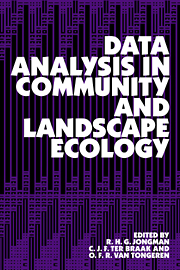Book contents
4 - Calibration
Published online by Cambridge University Press: 11 October 2009
Summary
Introduction
In Chapter 3, we used regression analysis to analyse the way in which species respond to environmental variables. The goal of regression analysis is to express the response of a species as a function of one or more environmental variables. In this chapter, we consider the reverse problem: namely how to express values of an environmental variable as a function of species data. This function is termed the ‘transfer function’ or ‘biotic index’ and its construction is termed calibration. The calibration problem differs from the regression problem, because the causal and statistical relations between species and environment are asymmetric.
It might be thought easier to measure environmental variables at a site than to infer their values from the species that occur there. But often it is not. For example, total values over time may be required; repeated measurements are costly, while species automatically integrate environmental conditions over time. This is one of the ideas behind biological evaluation of water quality and bio-monitoring in general. There are also situations where it is impossible to measure environmental variables by direct means, whereas a biological record does exist. An example is the reconstruction of past changes in acidity (pH) in lakes from fossil diatoms from successive strata of the bottom sediment.
An indicator species is ideally a species that always occurs under a unique set of environmental conditions and does not occur elsewhere. Such an ideal indicator species indicates its unique set of environmental conditions without error.
- Type
- Chapter
- Information
- Data Analysis in Community and Landscape Ecology , pp. 78 - 90Publisher: Cambridge University PressPrint publication year: 1995
- 17
- Cited by



